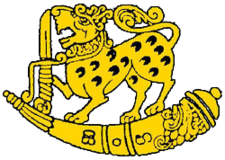Along with receiving independence from British rule on 4th February 1948, it became the responsibility of the Government to protect the sovereignty and territorial integrity of the Island. In order to meet this challenge raising and maintaining a standing army was a necessity. Thus, the volunteer force the British had left was supplemented with a regular force by the Government.
As the Government felt the need for expanding the infantry capability of the Army a Rifle Regiment designated the 1st Battalion Ceylon Sinha Regiment was raised on 1st October 1956 with its headquarters at the Imperial Camp in Diyatalawa. Lieutenant Colonel RD Jayatilleka MBE was appointed as its first Commanding Officer.
Meanwhile, the ‘C’ Company of the 2nd Volunteer Battalion of the Ceylon Light Infantry was re-designated as the Rajarata Rifles under the command of Lieutenant Colonel SD Ratwatte. The Rajarata Rifles was soon re-designated as the 2nd Volunteer Battalion of the Ceylon Sinha Regiment thus giving birth to the volunteer counterpart of 1st Battalion the Ceylon Sinha Regiment.
On 1st October 1969 the 3rd Volunteer Battalion the Ceylon Sinha Regiment was raised at Hill School, Nuwara Eliya. Later, on 22nd May 1972 when Sri Lanka became a republic, the Ceylon Sinha Regiment that comprised of one regular battalion and two volunteer battalions was renamed as Sri Lanka Sinha Regiment.
With the unleashing of terrorism on Sri Lankan soil by the Tamil separatists in the early 1980s, the Sri Lanka Army had to expand to meet the threat to the nation’s sovereignty and territorial integrity. Consequently, the Sri Lanka Sinha Regiment too expanded and the following battalions were added to the Regiment.
4th Battalion Sri Lanka Sinha Regiment - 01.12.1985 - Ambepussa Camp
5th Battalion (Volunteer) Sri Lanka Sinha Regiment - 01.02.1987 - Kandy Camp
6th Battalion Sri Lanka Sinha Regiment - 01.08.1987 - Ampara Camp
7th Battalion Sri Lanka Sinha Regiment - 12.05.1990 - Ambepussa Camp
8th Battalion Sri Lanka Sinha Regiment - 16.10.1992 - Konduwatuwana Camp
9th Battalion Sri Lanka Sinha Regiment - 01.01.1993 - Welioya Camp
10th Battalion Sri Lanka Sinha Regiment - 23.01.1994 - Sankattaravayal Camp
11th Battalion (Volunteer) Sri Lanka Sinha Regiment - 16.04.1994 - Dewahuwa Camp
12th Battalion Sri Lanka Sinha Regiment - 09.12.1996 - Ambepussa Camp
14th Battalion Sri Lanka Sinha Regiment - 16.12.1996 - Ambepussa Camp
15th Battalion (Volunteer) Sri Lanka Sinha Regiment - Ponnalei Camp
16th Battalion Sri Lanka Sinha Regiment - 17.02.1997 - Ambepussa Camp
17th Battalion (Volunteer) Sri Lanka Sinha Regiment - 01.12.2007 - Kataragama Camp
18th Battalion (Volunteer) Sri Lanka Sinha Regiment - 30.03.2008 - Kalawanchikudai Camp
19th Battalion (Volunteer) Sri Lanka Sinha Regiment - 31.08.2008 - Katukeliyawa Camp
20th Battalion Sri Lanka Sinha Regiment - 01.10.2008 - Vavunikulam Camp
21st Battalion Sri Lanka Sinha Regiment - 01.12.2008 - Ambepussa Camp
22nd Battalion (Volunteer) Sri Lanka Sinha Regiment - 01.07.2009 - Ambepussa Camp
23rd Battalion Sri Lanka Sinha Regiment - 01.08.2009 - Pooneryn Camp
24th Battalion Sri Lanka Sinha Regiment - 01.10.2009 - Alampil Camp
As a result of the expansion of the Sri Lanka Sinha Regiment a Regimental Headquarters was established at Diyatalawa on 9th May 1988 at the same location where the Sri Lanka Sinha Regiment was raised in 1956. Brigadier D Wijesinghe assumed duties as the first Colonel Commandant of the Regiment. Later, on 21st October 1989, the Regimental Headquarters was relocated to Ambepussa along with the 1st Battalion Sri Lanka Sinha Regiment.
10th Sri Lanka Sinha Regiment rose on 23rd January 1994 at Sankattaravayal Jaffna. In 2006, this Battalion was made a part of the newly raised Mechanized Infantry Brigade in which it continues to be a Regiment thus was no longer part of the Sinha Regiment.
To meet the requirements that arose during the period operations were conducted in the North and East, the Army decided on establishing reserve battalions (RFT) to be deployed in the areas already ‘cleared’. The demand for trained soldiers for these reserve battalions was met with the soldiers who had previously received injuries while in the battlefield yet sufficiently able to carry out appropriate duties.
The following RFT battalions were raised on the dates against their names and placed under command to the Sri Lanka Sinha Regiment.





